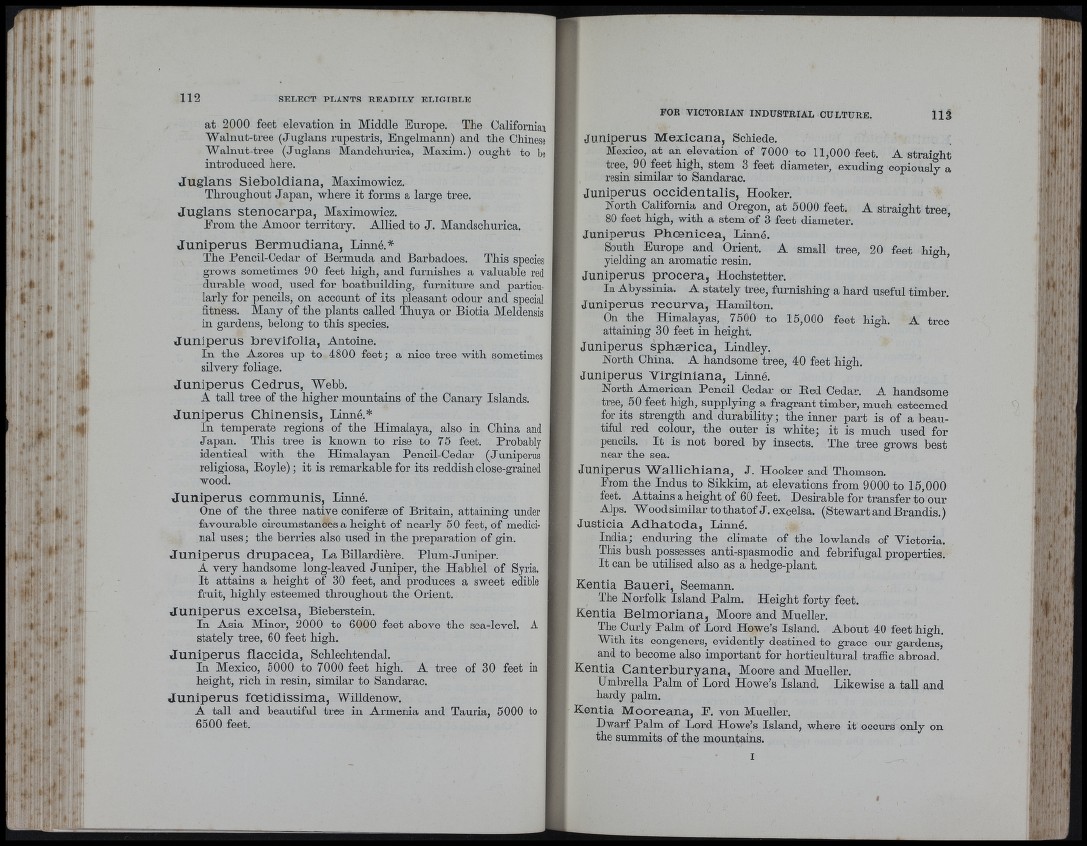
3,fi
' i«f
1' í ! C
at 2 0 0 0 feet elevation in Middle Europe. The Californian
Walnut-tree (Juglans rupestris, Engelmann) and the Chinese
Walnut-tree (Juglans Mandchurica, Maxim.) ought to be
introduced here.
Juglans Sieboldiana, Maximowicz.
Throughout Japan, where it forms a large tree.
Juglans stenocarpa, Maximowicz.
From the Amoor territory. Allied to J . Mandschurica.
Juniperus Bermudiana, Linné.*
The Pencil-Cedar of Bermuda and Barbadoes. This species
grows sometimes 90 feet high, and furnishes a valuable red
durable wood, used for boatbuilding, furnitui’e and particularly
for pencils, on account of its pleasant odour and special
fitness. Many of tbe plants called Thuya or Biotia Meldensis
in gardens, belong to this species.
Juniperus brevifolia, Antoine.
In the Azores up to 4800 feet; a nice tree with sometimes
silvery foliage.
Juniperus Cedrus, Webb.
A tall tree of tbe higher mountains of the Canary Islands.
Juniperus Chinensis, Linné.*
In temperate regions of the Himalaya, also in China and
Japan. This tree is known to rise to 75 feet. Probably
identical with the Himalayan Pencil-Cedar (Juniperus
religiosa, Boyle) ; it is remarkable for its reddish close-grained
wood.
Juniperus communis, Linné.
One of tbe three native coniferse of Britain, attaining under
favourable circumstances a height of nearly 50 feet, of medicinal
uses ; the berries also used in tbe preparation of gin.
Juniperus drupacea. La Biliardière. Plum-Juniper.
A very handsome long-leaved Juniper, the Habhel of Syria.
I t attains a height of 30 feet, and produces a sweet edible
fruit, highly esteemed throughout the Orient.
Juniperus excelsa, Bieberstein.
In Asia Minor, 2000 to 6000 feet above the sea-level. A
stately tree, 60 feet high.
Juniperus flaccida, Schleclitendal.
In Mexico, 5000 to 7000 feet higli. A tree of 30 feet in
height, rich in resin, similar to Sandarac.
Juniperus fcetidissima, Willdenow.
A tall and beautiful tree in Armenia and Tauria, 5000 to
6500 feet.
FOR VICTORIAN INDUSTRIAL CULTURE. 113
Juniperus Mexicana, Schiede.
Mexico, at an elevation of 7000 to 11,000 feet. A straight
tree, 90 feet high, stem 3 feet diameter, exuding copiously a
resin similar to Sandarac.
Juniperus occidentalis. Hooker.
North California and Oregon, at 5000 feet. A straight tree
80 feet high, with a stem of 3 feet diameter. ’
Juniperus Phoenicea, Linné.
South Europe and Orient. A small tree, 20 feet hi<^h
yielding an aromatic resin. ^ ’
Juniperus procera, Hochstetter.
In Abyssinia. A stately tree, furnishing a hard useful timber.
Juniperus recurva, Hamilton.
On the Himalayas, 7500 to 15,000 feet high. A tree
attaining 30 feet in height.
Juniperus spbærica, Lindley.
North China. A handsome tree, 40 feet high.
Juniperus Virginiana, Linné.
North American Pencil Cedar or Eed Cedar. A handsome
tree, 50 feet high, supplying a fragrant timber, much esteemed
for its strength and durability; the inner part is of a beautiful
^ red colour, the outer is white; it is much used for
pencils. I t is not bored by insects. The tree grows best
near tbe sea.
Juniperus Wallichiana, J . Hooker and Thomson.
From the Indus to Sikkim, at elevations from 9000 to 15,000
feet. Attains a height of 60 feet. Desirable for transfer to our
Alps. Woodsimilar to that of J . excelsa. (Stewart and Brandis.)
Justicia Adhatoda, Linné.
India; enduring the climate of the lowlands of Victoria.
This bush possesses anti-spasmodic and febrifugal properties.
I t can be utilised also as a hedge-plant.
Kentia Baueri, Seemann.
The Norfolk Island Palm. Height forty feet.
Kentia Belmoriana, Moore and Mueller.
The Curly Palm of Lord Howe’s Island. About 40 feet high.
With its congeners, evidently destined to grace our gardens,
and to become also important for horticultural traffic abroad.
Kentia Canterburyana, Moore and Mueller.
Umbrella Palm of Lord Howe’s Island. Likewise a tall and
hardy palm.
Kentia Mooreana, E. von Mueller.
Dwarf Palm of Lord Howe’s Island, where it occurs only on
the summits of the mountains.
HU I'
1 i '
’Ml
I >
' !
■M: 1 »